
The coat of arms and the flag that serve as the symbols of the Radomsko County, Łódź Voivodeship in Poland. They were established in 2000.

The coat of arms that serves as the official symbol of the Masovian Voivodeship, Poland, consists of a red escutcheon, that features a white (silver) eagle, with raised wings, and its head turned left. Its current version had been designed by Andrzej Heidrich, and adopted in 2006.

The flag that serves as the symbol of the historical and geographical regions of the Silesia, and Lower Silesia, and as one of the symbols of the Silesian people, is divided horizontally into two stripes: white on the top and yellow on the bottom. It originated as the flag of the Province of Silesia, used from 1882 to 1919, that later used as the flag of the Province of Lower Silesia, from 1920 to 1935. Currently, the flag is recognized symbol of the Silesian people in the state of Saxony in Germany.
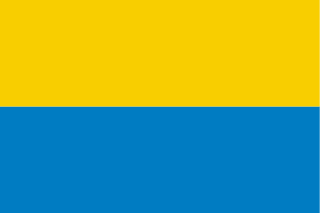
The flag that serves as the symbol of the historical and geographical region of the Upper Silesia, and as one of the symbols of the Silesian people, is divided horizontally into two stripes: yellow on the top and blue on the bottom. It originated as the flag of the Province of Upper Silesia adopted in 1920, with its colours based on the coat of arms of Upper Silesia. The flag is also popular symbol used by the Silesian Autonomy Movement.

The flag of the Podlaskie Voivodeship, Poland is a rectangle divided into four horizontal stripes, that are, from the top to bottom: white, red, yellow, and blue. It was designed by Tadeusz Gajl, and adopted on 30 August 2002.

The coat of arms of Kamień County, West Pomeranian Voivodeship located in Poland, is divided horizontally into blue and white stripes, with 2 golden (yellow) crosiers and 2 red roses within blue stripe, and red Griffin with yellow claws and beak, within the white stripe. The flag of the county is a rectangle divided horizontally into white and blue stripes, with the coat of arms in the middle.
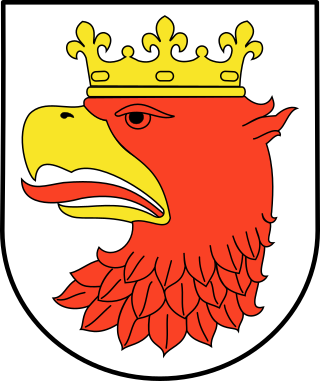
The coat of arms of the town of Police in West Pomeranian Voivodeship, Poland depicts the head of a red griffin with a yellow (golden) beak, and a yellow (golden) crown, place on the white (silver) background.
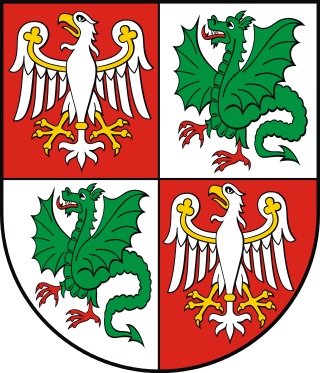
The coat of arms and the flag that serve as the symbols of the Warsaw West County, Masovian Voivodeship, in east-central Poland.

The flag that serves as the symbol of the historical and geographical region of the Western Pomerania is divided horizontally into two stripes: light blue on the top and white on the bottom. It originated as the flag of the Province of Pomerania, Prussia, used from 1882 to 1935. Since 1996, it is officially recognized as the symbol of the historical region of Western Pomerania within Mecklenburg–Western Pomerania, Germany.

The flag that serves as the symbols of the Koszalin County, West Pomeranian Voivodeship, in western-norther Poland was established in 2001, and the coat of arms, in 2002.

The civil flag of the city of Gorzów Wielkopolski in Lubusz Voivodeship, Poland is divided into three equally-sized horizontal stripes, of green, white, and red. The first design of the flag was adopted in 1991, and its current version, in 1994.

The coat of arms and flag that serve as the symbols of the Police County, in West Pomeranian Voivodeship, Poland were established on 28 June 2000. They were designed by Radosław Gaziński.
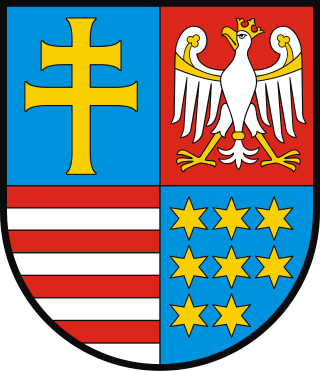
The coat of arms that serves as the symbol of the Świętokrzyskie Voivodeship, Poland, consists of the Iberian style escutcheon (shield), with square top and rounded base, that is divided in the 2 by 2 chessboard pattern. The top left field features a yellow patriarchal cross. The top right field features a white eagle with yellow crown, beak, legs, stripes on its wings, and a ring on its tail. The bottom left field features eight yellow six-pointed starts, placed in three rows, each with three stars, with the exception of the bottom row, that only had 2 stars, placed to the left.

The coat of arms of Sandomierz County is divided vertically into two fields, with the left field consisting of six horizontal stripes, alternating between red and white (silver) colours, and the right field featuring nine yellow (golden) six-armed stars, placed in three horizontal rows. The flag of the county divided into three vertical stripes, of blue, yellow, and blue colour, with the middle stripe being three times, and the coat of arms placed in the centre. The design was based on the historical coat of arms of the Sandomierz Voivodeship, used from 14th to 18th centuries.

The coat of arms of the town of Białogard, Poland, depicts a red griffin standing on its back legs, above the blue horizontal wavy line. The current coat of arms was established in 2004.

The coat of arms of Dęblin, Poland depicts a depicts the Eagle of Zeus, in form of a light gray (silver) eagle, which holds a yellow (golden) globe from which emerge four lightning bolts, placed on a blue field. The flag of Dęblin is divided into three horizontal stripes, that are white, yellow, and blue, with the top and the bottom stripes are twice the size of the middle stripe. They are, from top to bottom, white, yellow, and blue. The current town symbols were introduced in 1993, and designed by Dariusz Dessauer. The original town coat of arms was introduced in 1974.

The coat of arms of Pomerania, also known as the Pomeranian Griffin, is the symbol of Pomerania, a historical region on the southern shore of the Baltic Sea in Central Europe, split between Poland and Germany. It depicts a red griffin with yellow (golden) beak and claws, placed within a white (silver) shield. It originates from the late 12th century.
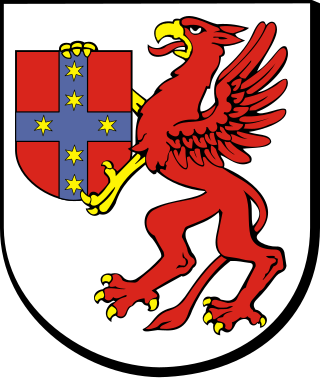
The coat of arms of Szczecinek County, West Pomeranian Voivodeship, Poland, depicts a red griffin holding a red shield with blue cross and six six-pointed stars on it, placed in a white escutcheon (shield). The flag consists of three vertical stripes, which are white, red, and white, with the middle red stripe being three times wider than the others. In its centre is placed the coat of arms. Both symbols were established on 4 November 1999.
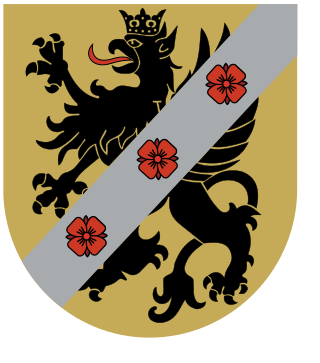
The coat of arms of Wejherowo County, Pomeranian Voivodeship, located in north-central Poland, consists of a black griffin with a black crown on its head, and a grey (silver) band (stripe) running from the top right to the bottom left corner of the shield, with three red roses on it. The design is placed within a light orange (golden) escutcheon (shield). The flag of the county is divided vertically into two stripes of identical width; black on the left, and light orange on the right. In the centre of the left field is placed the coat of arms. Both symbols were established in 2000.























